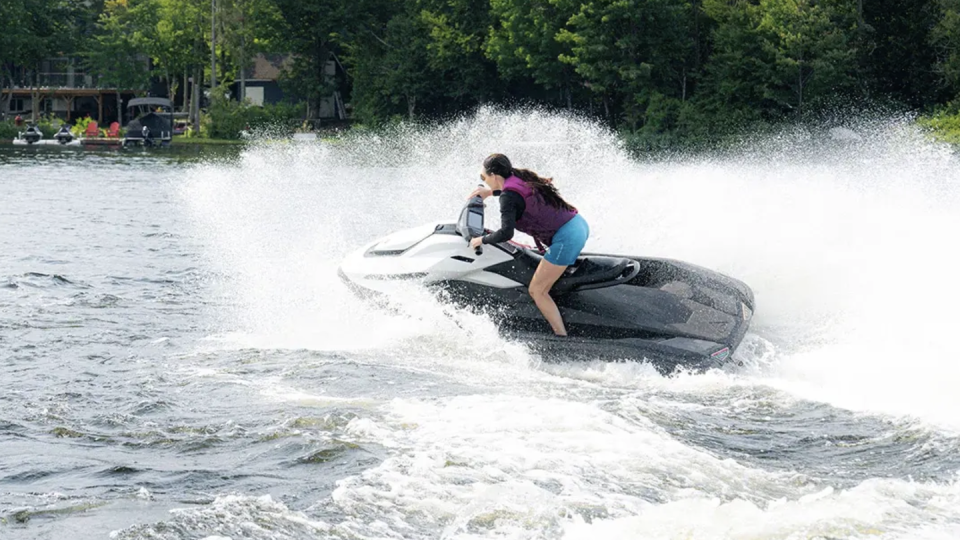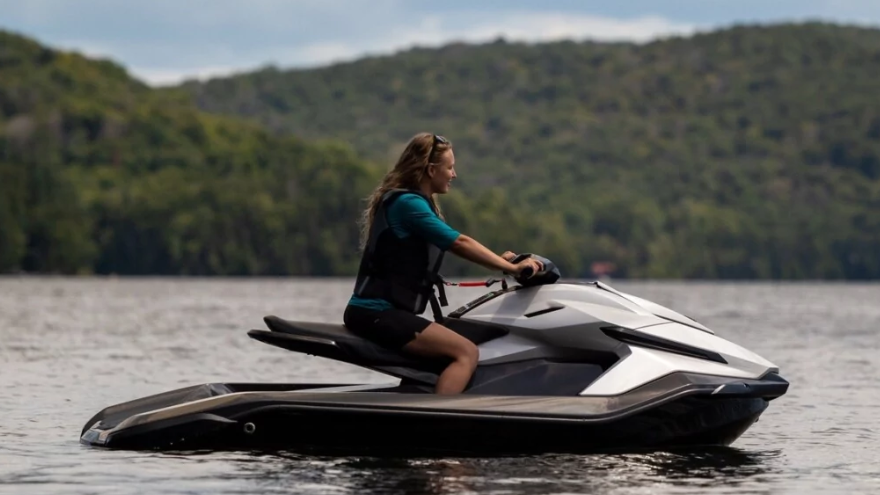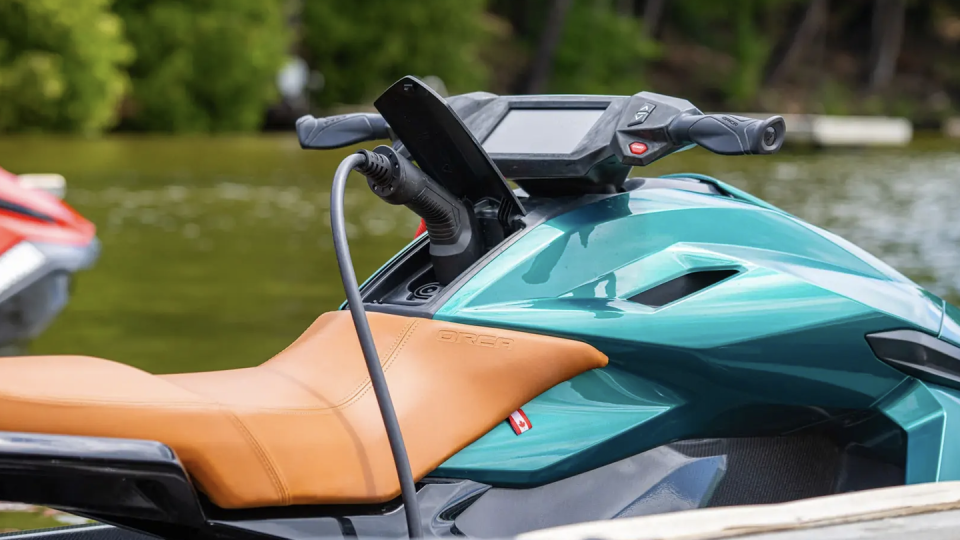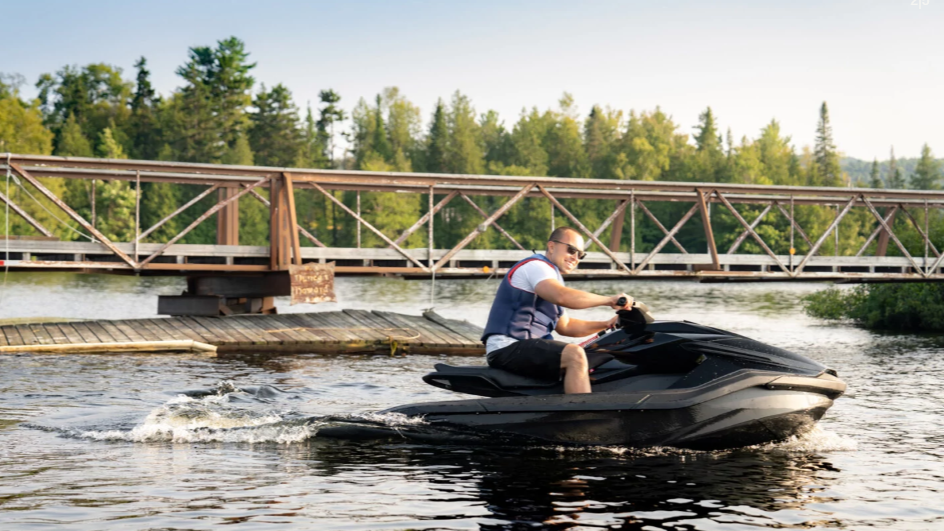Electric Jet Ski Is Good, Clean Fun—without Much Noise

Taiga Motors is a small company in Toronto that makes all-electric PWCs (personal watercraft—generically and illegally referred to as jet skis).
With 160 hp, the Taiga Orcas go up to 60 mph on the water and can last as long as an hour and a half. Or so. Range is up to 25 or 30 miles. Or so.
Prices start at $19,490 US (though the company website also says $17,490).
There I was, slamming across the corduroy wavelets of Mission Bay at what felt like about 60 mph, whappity-whap-whapping over tiny folds of salt water that slapped angrily into my craft’s hull, wind blasting my face, fish freaking out below, seagulls complaining with loud squawks. I was generally having a blast.
And yet I wasn’t spewing any tailpipe emissions whatsoever into the atmosphere. Nor was I making very much noise. It was just good, clean, fun. Because I was riding an all-electric personal watercraft, or PWC. Two of them, in fact, (not at the same time). One was made of “composites,” and the other of carbon fiber. Both were made by a Toronto company called Taiga Motors, which also makes all-electric snowmobiles.

Taiga Motors was founded in 2015, went public on the Toronto Stock Exchange in 2021, and started making electric PWC and snowmobiles in 2022. In the first nine months of this year they produced 640 of both snowmobiles and PWC and are on track to finish the year with an even 1000. Taiga began delivery of the PWCs in August. If you order one now it’ll be ready for next summer’s fun.
Taiga Motors offers two models of personal watercraft—or generically, the copyright-infringing term, jet skis as I found myself calling them. The composite-bodied Orca model stickers at $19,490 (the website also says $17,490), while the much more rigid Orca Carbon starts at $26,500 US.

For comparison’s sake, you can get an internal-combustion-powered Kawasaki Jet Ski SX-R 160 for $11,999, or a Jet Ski Ultra 310 three-passenger supercharged model for $19,199. All three Kawasaki Jet Ski models are powered by 1.5-liter four-stroke DOHC inline-fours with no horsepower listed.
The Taiga Orca doesn’t list specifics of its electric motor except that it makes 160 hp and will run for up to two hours. With three different drive modes, it can go as far as 25 miles, though some conversations with Taiga have range as high as 30 miles. It all depends on whom you ask and how you ride, or ski.
And, with San Diego’s Mission Bay empty on a Tuesday, I was skiing flat-out.
PWCs are intensely fun for about a half hour, then their appeal tapers off a little.
“What we find is that our customers usually ride for an hour to an hour and a half, doing a bit of donuts, a bit of acceleration, a little bit of wild mode, mostly sport mode. And then they come back to the dock to charge,” said Taiga’s marketing director Annick Lauzon.
At Level 2 charging (240 volts), you can recharge your Orca from empty to full in 3.5 hours. If you get the optional Level 3 connector, have access to a Level 3 charger, and can tow your Orca to it, recharge time is just 40 minutes. No recharge time is listed for a regular old 120-volt outlet but it would probably be full after an overnight plugged in at the dock.
The difference between the two Orcas is palpable. The composite hull is much more forgiving, maybe even more comfortable. The carbon-fiber is stiff, stiff, stiff, and probably faster if you were doing an Orca-to-Orca comparison with instrumented testing.
On waves larger than the ripples of Mission Bay, the composite body would be easier on your knees and kidneys. But if you were after pure performance, you’d want the Orca Carbon.

There was an anomaly during my day on the raging sea. The composite-body Orca kept dying. It would go along at full throttle for a few minutes, then stop. It took a few hits of the start button to get it going again, then it would run for another few minutes and die again. I never got an explanation for this from Taiga, but the Orca Carbon model never faltered.
Both were a blast. Taiga says most customers have one of these along with a few electric cars. They keep an Orca at their cottage, as they say in the north, or some keep them at their waterfront home in Florida. Many have one or two on their yachts. This would be nice.
Should you buy one instead of a conventional gasoline-powered PWC? They are quieter, require no gas or oil, eliminate almost all maintenance, and you can even sneak up on fish or gators with them. The advantages are limited only by your creativity.
And if you charge them off solar panels on your cottage or large sailboat, you can be off the grid. I can tell you they were as much fun as conventional PWCs I have ridden, minus the noise and exhaust. If your cottage is on a quiet lake, your neighbors will appreciate the electric alternative.
What I really need is to buy one of those electric snowmobiles for the mountain cabin in Colorado. Then I need to get a mountain cabin in Colorado. Anybody want to go in on this?
Have you spent much time riding personal watercraft, either electric or internal-combustion? Please comment below.

 Yahoo Autos
Yahoo Autos 